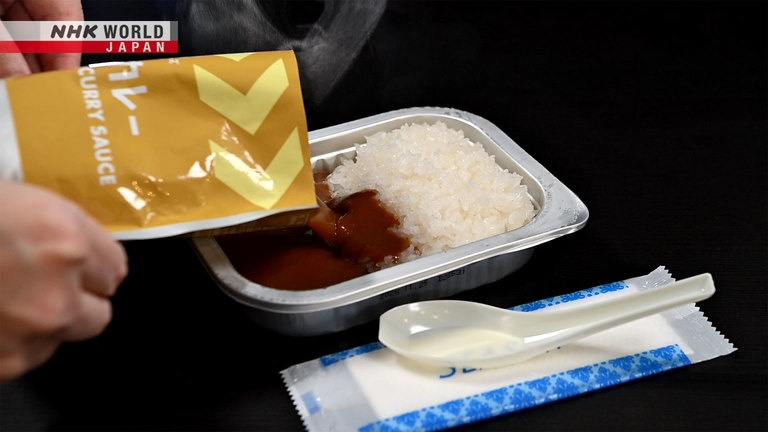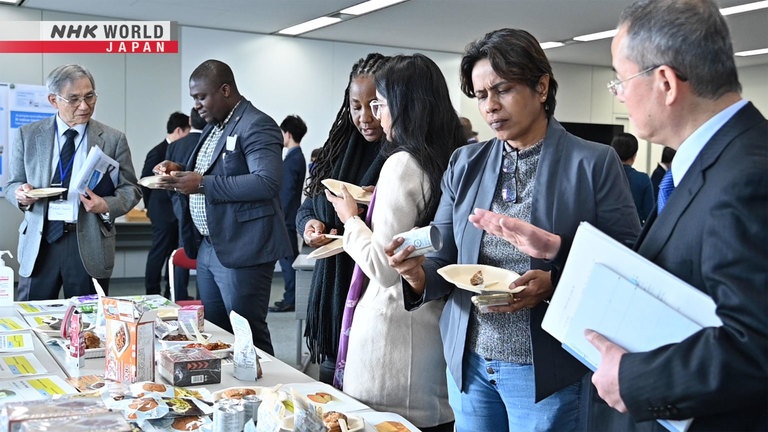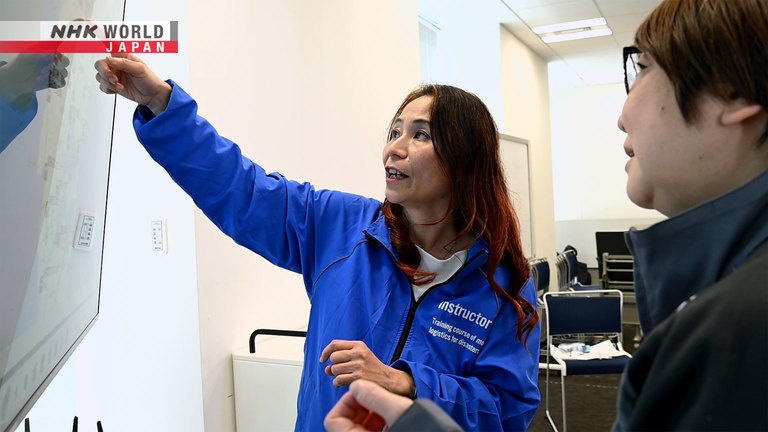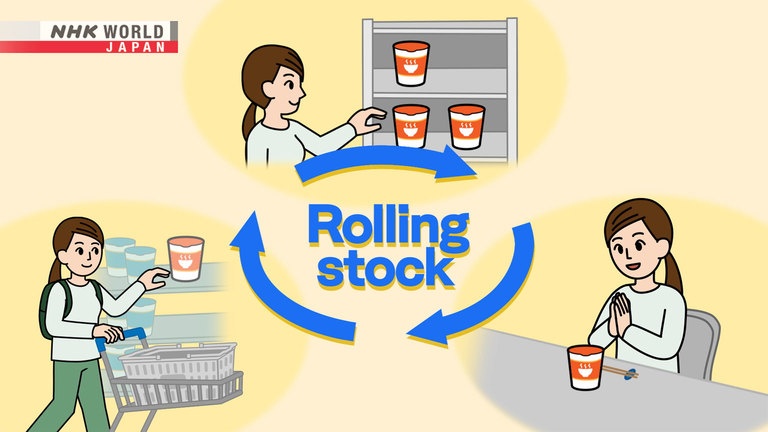#39 Emergency Food
Find out about Japan's emergency food options that meet the needs of various people. Also discover the rolling stock method, a smart way to stockpile emergency food.




Transcript
Japan has a long history of natural disaster.
Now, the power of science is helping to overcome them.
BOSAI: Science that Can Save Your Life.
Japan has suffered numerous natural disasters from earthquakes to typhoons.
From these experiences, some things have undergone major changes.
Emergency food.
Using self-heating packaging, this curry and rice is served warm without a stove.
This low-sodium stew can be eaten by people with high blood pressure.
These are halal certified.
Various problems have occurred during disasters due to challenges in preparing meals.
Such bitter experiences have led to the creation of these types of emergency food.
Although emergency biscuits provide
the minimum energy to survive,
it can lead to nutritional deficiencies
in the long run.
Also, people in Japan have developed a unique way to stock food.
Have you ever heard of the rolling stock method?
This storing method was invented in Japan.
Today, we'll introduce Japan's cutting-edge research on emergency food.
March 2011.
Japan was struck by a massive earthquake.
It measured a magnitude of 9.0.
Three months after the earthquake, roughly 125,000 people still had no choice but to live at evacuation centers.
Among the challenges they faced were issues related to food.
This is Nobuyo TSUBOYAMA who conducted a survey at evacuation centers.
When did you arrive after the Great East Japan Earthquake?
On the 3rd week.
It was after some time.
The earthquake caused extensive damage and
there was a food shortage even after 3 weeks.
People received 1 or 2 meals a day
with very small portions.
It was a dire situation.
Roads, railways and other means of transportation were disrupted, causing food shortages.
The most affected were babies,
elderly people who couldn't chew food,
and people with food allergies.
They were struggling to find things to eat.
And it was still cold in March.
Yes, there was a need for hot meals.
Later, the transportation system gradually recovered, and food began to reach the evacuation centers.
However, a new problem had surfaced.
Please take a look at this.
And this is?
This is a study of the food supply
based on a survey at 67 evacuation centers.
We found that most items
were in short supply except for one,
which was in excess.
Can you guess which one?
Excess supply....what can it be?
The answer is carbohydrates, grains.
Carbohydrates? That's a surprise.
Carbohydrates, abundant in bread, noodles and rice, are essential for human survival.
They were in surplus at several evacuation centers.
On the other hand, there was a significant shortage of meat, vegetables and dairy products.
Consuming energy-rich grains is beneficial
soon after the disaster.
However, we need to increase food variety
as nutritional deficiencies and malnutrition arise.
They are starting to understand that such nutritional imbalances pose a major health risk.
For instance, high blood pressure is the cause of various diseases.
Consuming high-sodium foods such as instant noodles, canned foods and meal pouches worsen high blood pressure.
It has been reported that the risk of heart disease rose by 1.5 times and stroke by 1.9 times due to the stress of the disaster.
In addition, excess sugar intake can cause diabetes.
According to a survey conducted in one area affected by the Great East Japan Earthquake,
the prevalence of obesity among men had increased by roughly 10% in a year and a half of living at evacuation centers.
On the other hand, Tsuboyama believes that such health risks can be reduced by improving the dietary environment.
Our studies found that dairy products are effective
for hypertension that occurs during disasters.
Also, seafood is beneficial for obesity
that develops due to long-term evacuation.
Here are the results of a survey conducted on about 10,000 survivors of the Great East Japan Earthquake.
People who did not consume any dairy products in temporary housing were set as a reference.
The risk of high blood pressure was about 38% lower for those who consumed dairy products once a day,
and it was 32% lower for people who consumed it twice a day or more in temporary housing.
They also found that men who ate seafood more frequently had a lower risk of becoming obese.
Tsuboyama believes taurine and fatty acids found in fish may have an impact and is investigating the mechanism.
Emergency food is not just about satisfying hunger,
but plays an essential role in
helping people recover from disasters.
After the Great East Japan Earthquake,
we've encountered various disasters
and faced food-related issues each time.
We now understand the importance of
emergency food that give us comfort,
food that meets the needs of babies,
older adults and those with allergies.
Japan has learned from experience, the importance of food in times of disaster.
And now, we are starting to see major changes in emergency food.
There's a wide range of choices.
Our goal is to offer food options
for every individual.
We believe food diversity is essential.
Food diversity offers various meal choices that take into account different backgrounds
such as culinary culture, religion and health considerations.
Specifically, we offer food
free from allergenic substances
or food that caters to religious dietary
restrictions.
They're halal food.
Yes. Halal certified food.
Allergen-free food have completely separate production lines to prevent any risk of cross-contamination.
I am vegan.
Do you have any vegan products?
- Yes, of course.
- You do?
This vegan-friendly product makes "onigiri," a rice ball just by adding hot or cold water.
Looks tasty. Let me try it.
How is it?
It has a nice "kombu" flavor.
To develop products that are both tasty and easy to make, they are coming up with innovative ideas.
Allergy-friendly food is a challenge
due to ingredient restrictions,
but we make daily efforts
to deliver tasty emergency food.
Currently, Japan's emergency food is leading the world.
The certification system that started in Japan 9 years ago,
verifies the quality and food safety management of emergency food.
In 2023, the International Organization for Standardization, ISO,
approved to start discussions on a global standard based on Japan's criteria.
Detailed discussions among various countries are scheduled to take place in the future.
Learning from past experiences,
we've improved our system
and enhanced our products.
Our knowledge could be applied in other countries,
as natural disasters become more common.
Here in Japan, every household is encouraged to stock up on emergency food.
And we have a unique way of doing so.
It's called the rolling stock method.
Rolling stock is not a special type of emergency food,
but rather a method of having a little extra of your regular groceries in stock,
and consuming the ones with the earliest expiration dates first.
By restocking what you consume, you maintain a consistent supply of food at all times.
We got some advice from an expert in this method.
People often ask
"What should I eat after a disaster?"
But I tell them
"How can you eat what you normally eat?"
When disaster strikes, the continuing
abnormal situation is the cause of stress.
So eating what you normally eat
will be comforting.
I see. What are some examples?
Here are some of my favorites.
There are so many.
Everything from curry in a pouch
to various pasta sauce.
If you them in your daily life,
you'll know what you like.
The key is to make sure the expiration and the storage place are visible.
I keep mine on a bookshelf.
My family can see there's food there,
so it becomes easy to use.
The expiration is facing us.
You write the date on it.
It's very clear.
Food that expires sooner are on the left.
We use food from the left side.
That creates space here and
we know how many are gone.
You know how much to buy!
We should stock up enough food for the family to last at least 3 days, ideally enough for 1 to 2 weeks.
For water, it's recommended to stock up 3 liters per person per day for 3 days.
And ideally, have a 7-day supply.
Anywhere in the world,
people can get sick suddenly.
Having food at home provides peace of mind.
So I encourage people to adopt
the rolling stock method.
Natural disasters can significantly disrupt the way we live and affect our mental wellbeing.
Through the interviews, I've come to realize that having a variety of food is particularly crucial during such times.
What did you think of Japan's efforts in preparing emergency food?
Perhaps you can adopt similar ideas in your community.